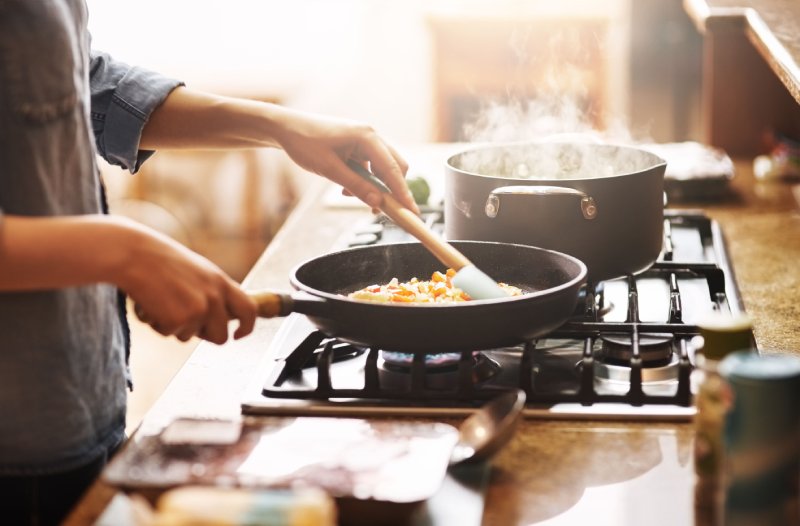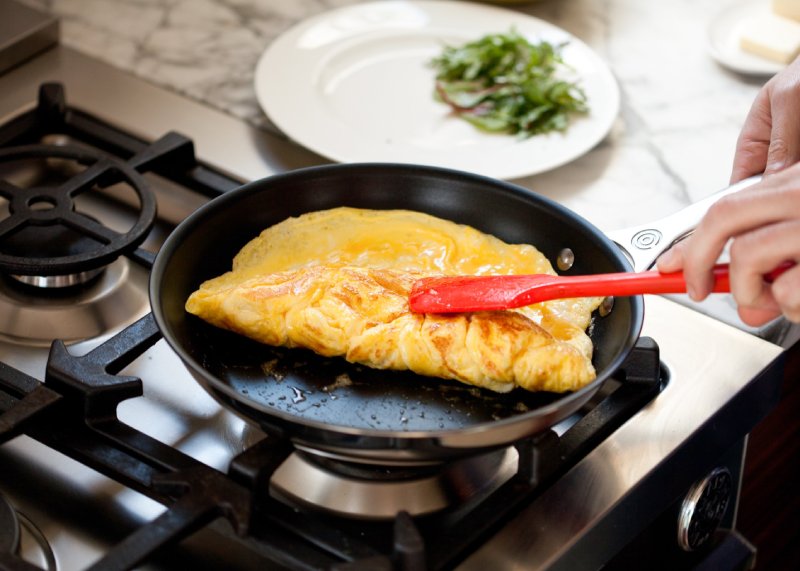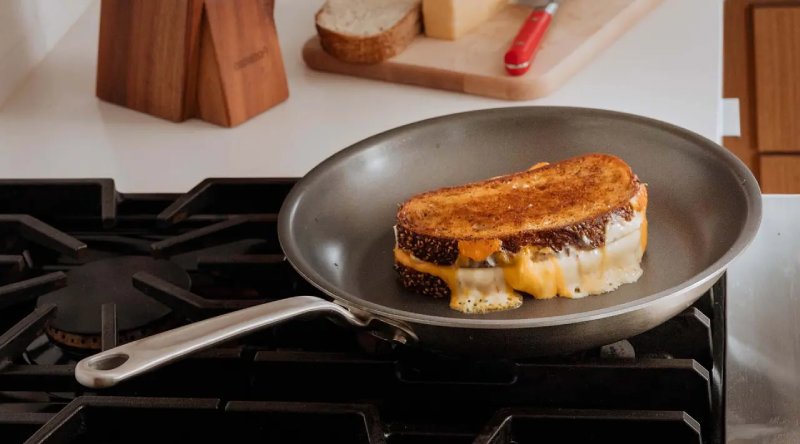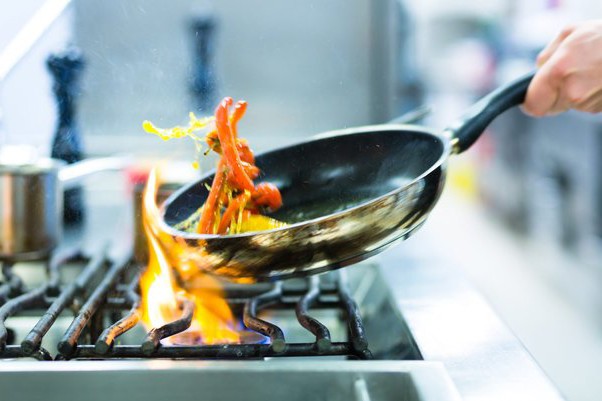Can you use nonstick pans on a gas stove? While the answer isn’t always straightforward, there are many advantages to cooking with a nonstick pan and some associated risks. Whether you need it for its fast and even heating, easy clean-up, or health benefits, understanding how to use a nonstick pan correctly can help ensure that your experience is profitable and safe.
In this blog post, we will discuss the critical elements of successful nonstick cooking when using a gas stove so that you can make an informed decision about whether or not it is right for you.
The Science Behind Nonstick Pans
Materials used in nonstick pans
Nonstick cookware is designed to be used on gas stoves, but there are a few things you need to know. Nonstick pans are usually made with a coating of polytetrafluoroethylene (PTFE). This synthetic material is known for its low-friction properties and chemical resistance, making it useful in many applications like aircraft surfaces, electrical insulation, and nonstick cookware.
There have been concerns about using PTFE for cooking due to reports that it can release toxic fumes when heated at high temperatures. However, manufacturers have addressed this issue by adding perfluorooctanoic acid (PFOA) to the mix during production. This component helps prevent the release of harmful fumes, making nonstick pans safe to use on gas stoves.

How nonstick surfaces work
Nonstick surfaces are designed to reduce the amount of food that sticks to the pan while cooking. This is achieved through low-friction materials, non-toxic coatings, and elevated temperatures. When heated up, the molecules in these surfaces expand, creating an ultra-thin layer of air between them and whatever is being cooked. This layer of air helps to prevent food from sticking, making it easier to cook and clean.
Benefits of nonstick pans
Nonstick pans are great for cooking, especially on a gas stove. They heat up quickly, evenly distributing heat and reducing the likelihood of burning or scorching food.
Due to their low-friction surfaces, they also require less oil or fat when cooking, allowing you to prepare healthier meals with fewer calories and saturated fats. Plus, they’re much easier to clean than traditional pans, requiring a quick rinse rather than a lengthy scrub.
Gas Stoves: A Quick Overview
How do gas stoves work?
Gas stoves work by utilizing gas fuel that is connected to a burner head through piping. The gas then flows from the burner head and, when ignited with an electronic spark or pilot light, heats the cooking surface known as the “cooktop.”
Advantages of using gas stoves
Gas stoves are more energy-efficient than electric stoves and provide faster heating, so they are often preferred by those who need to cook quickly. Moreover, gas stoves offer more control over the temperature setting, letting you adjust the heat instantly.
Types of gas stoves: open flame and sealed burners
Gas stoves come in two types: open flame burners and sealed burners. Open flame burners feature an exposed burner lit by a pilot light or electric spark, while sealed burners are protected with a griddle-style surface that shuts off the gas.
Can nonstick pans be used on a gas stove?
Yes. Nonstick pans can be safely used on a gas stove, provided that you use the correct heat setting and keep a close eye on your cooking. When using nonstick cookware, it is essential to avoid high heat as this can cause the coating to degrade over time.
Additionally, ensuring your cooktop is clean before placing the pan on it is crucial, as crumbs and other particles can cause the nonstick coating to chip or flake off.

Compatibility of Nonstick Pans with Gas Stoves
Why it’s important to consider compatibility?
Using the wrong kind of cookware on a gas stove can cause damage to both the pan and the stove, as well as potential safety hazards. It’s crucial to consider compatibility when selecting cooking materials for your kitchen. When choosing cookware for gas stove, nonstick pans are an option.
Factors that determine compatibility
Several factors must be considered when determining the compatibility of nonstick pans with a gas stove. The pan should have flat bottoms that fully cover the bottom area of the burner to maximize heat transfer. In addition, the size of burners will affect how evenly heat is distributed across a pan.
Finally, it’s essential to consider a stove’s heat output. Some nonstick pans may be too delicate to withstand high-heat temperatures, so selecting a pan appropriate for your stove’s production is necessary.
How to determine if your nonstick pan is suitable for gas stoves
Before using a nonstick pan, it’s essential to check the manufacturer’s instructions for compatibility and use guidelines. Additionally, you may need to adjust your stove settings to ensure the pan receives even heat distribution. If in doubt, it is best to err on the side of caution and purchase cookware specially designed for gas stoves.
Using Nonstick Pans on Gas Stoves: Pros and Cons
Pros:
- Faster heating: Nonstick pans can heat up to the desired temperature much quicker than traditional pans, which is especially beneficial when using a gas stove.
- Better temperature control: Nonstick pans are better for controlling the temperature since their coating prevents food from sticking and burning, even when using high heat.
- Enhanced flavor due to open-flame cooking: The open flame of a gas stove can add extra flavor to food cooked in nonstick pans.
Cons:
- Potential for uneven heating: Gas stoves can be difficult to control and may cause nonstick pans to heat unevenly.
- Increased risk of damaging nonstick coating: The high heat of a gas stove can damage the nonstick coating over time, reducing its effectiveness.
- Shorter lifespan of the nonstick pan: Nonstick pans used on gas stoves may only last for a short time, as the higher heat can degrade the pan’s coating more quickly than other cooking methods.
Considering nonstick pans on a gas stove, weighing the pros and cons before deciding is essential. While there are benefits to using nonstick pans on gas stoves, risks should be considered. However, with careful monitoring and good technique, nonstick pans can be used on a gas stove successfully.

Tips for Using Nonstick Pans on Gas Stoves
- Selecting the correct pan size: When cooking on a gas stove, choosing the right pan is essential. If the pan is too large, the gas flame cannot heat it evenly. Additionally, if the bottom of the pan extends beyond the radius of your stove’s burner, you may put excessive strain on both your stove and pans.
- Preheating the pan properly: Proper preheating of your nonstick pan is essential for success. Heat your nonstick pan over low to medium heat before adding oil or butter to prevent the food from sticking, and allow the pan to heat evenly.
- Lowering the heat when cooking: Lowering the temperature of a gas stove after the pan has been heated can help reduce the heat generated and prevent sticking and excessive browning.
- Regulating heat settings: It is also essential to control the heat settings of your gas stove. Too much heat can cause food to burn or stick, so it is best to maintain a constant low-medium heat level throughout the cooking process.
- Using appropriate utensils: Nonstick pans are designed for non-metal utensils, such as wooden or plastic spoons. Metal utensils can easily scratch the surface of a nonstick pan and cause it to become less effective over time.
- Cleaning and maintenance tips: Proper cleaning and maintenance can help extend your nonstick pan’s life. After use, allow the pan to cool before washing it with mild detergent and warm water. It is also important to avoid abrasive cleaners, steel wool, and scrubbing pads, as these can damage the nonstick coating.
Alternatives to Nonstick Pans for Gas Stoves
- Stainless steel pans: Stainless steel is an excellent option for gas stove use. It heats quickly and evenly, doesn’t require much oil to cook with, and has excellent heat conductivity. Plus, stainless steel pans are relatively inexpensive compared to nonstick-coated options.
- Cast iron pans: Cast iron is an old-school favorite for cooking on a gas stove. The metal is highly durable and conducts heat exceptionally well, making it suitable for searing that perfect steak or sautéing vegetables. With proper seasoning and care, cast iron pans will last a lifetime.
- Ceramic-coated pans: If you’re looking for something nonstick but want to avoid using Teflon, ceramic-coated pans are a great option. They don’t contain the same harmful chemicals that can be released from Teflon-coated pans, and they require less oil than traditional stainless steel or cast iron options. Plus, their slick coating makes clean-up a breeze.
Safety Precautions When Using Nonstick Pans on Gas Stoves
- Avoid overheating the pan: Nonstick pans should not be heated beyond their recommended maximum temperature, usually, 500°F (260°C), as overheating can cause the pan to warp and release hazardous fumes.
- Ventilation and fumes: Operating a gas stove in well-ventilated areas. The fumes released using nonstick pans may contain harmful particles, and adequate ventilation will help disperse them.
- Properly disposing of damaged nonstick pans: If a pan has become warped or otherwise damaged, it should be disposed of properly rather than reused. Nonstick pans contain chemicals that can be hazardous if inhaled, so they must be disposed of safely to protect yourself and others.
- Using utensils designed for nonstick surfaces: Since metal utensils can scratch nonstick surfaces, it is essential to use knives designed explicitly for nonstick cookware when using a gas stove.

Frequently Asked Questions (FAQs):
Are there specific brands of nonstick pans that are better for gas stoves?
Yes, some specific brands have designed their nonstick pans specifically for use on a gas stove. Some of these brands include T-fal, Farberware, and Anolon. It is essential to look for pans made of sturdy materials such as stainless steel or cast iron because they will be less likely to warp with the intense heat that a gas stove provides.
How can I extend the lifespan of my nonstick pan when using it on a gas stove?
It is vital to ensure that the heat on your gas stove is manageable. If you need to adjust the flame, turn it down gradually rather than turning it up and then trying to lower it quickly.
Can I use a nonstick pan on an induction stovetop?
Yes, nonstick pans can be used on induction cooktops. It is essential to ensure that the bottom of your nonstick pan is entirely flat to make proper contact with the stovetop. Pans with warped bottoms can cause uneven heat distribution, making cooking your food difficult.
How do I know if my nonstick pan is damaged and needs to be replaced?
If your pan is starting to show signs of wear and tear, such as scratches or chips in the nonstick coating, then it may be time to replace it. Additionally, if you notice that food is sticking to the surface or burning more quickly than usual, this can also be a sign that your pan needs to be replaced.
What should I do if the nonstick coating starts to peel off?
It is important to immediately stop using the pan if the nonstick coating is peeling off. Nonstick coatings can be harmful when ingested, so it is essential to dispose of a damaged pan immediately.
Conclusion on Can you use nonstick pans on a gas stove?
It is generally safe to use nonstick pans on a gas stove. However, any cookware should be used responsibly to avoid damage or injury. Ensure you follow the manufacturer’s guidelines and take extra care when using higher heat settings.
Additionally, please pay attention to the pan’s temperature and regularly check for signs of wear and tear that could affect its safety. With these precautions in mind, you can ensure your nonstick cookware lasts longer and serves you well on your gas stovetop.
Related post:

